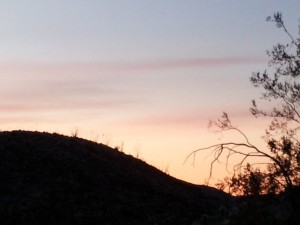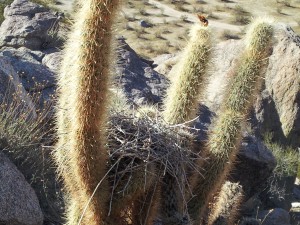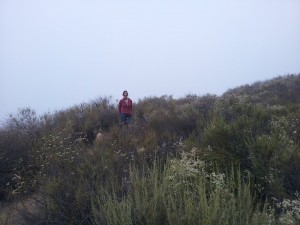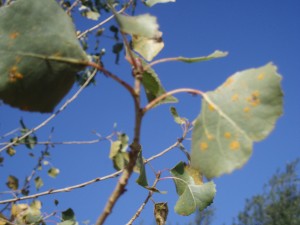 posted by Sheri McGregor
posted by Sheri McGregor
At dusk, the whirring call of a Ladderback woodpecker echoes along the desert slopes, the eerie sound reminiscent of an old outer space movie soundtrack. Night falls more slowly in wide Blair Valley and Little Blair Valley in Anza Borrego Desert State Park. Camping beneath the long stretches of sky in this theater of open space, we can see the light until its last straining moment. The sun crouches beyond the western ridges of the desert horizon, and the pink glow fades. The tented sky darkens, and dots of light – – twinkling, steady, or shooting – – grow bright.
In the morning, sunlight creeps in from the east, dispelling shadows, sparking glints of pyrite in the rocks, sucking up gathered night moisture, and warming the land. Crows soar off rocky hilltops, beckoning early hikers. Official area trails include Pictograph Trail where an isolated boulder bears primitive artwork from the past. Neighboring this trail is a short, easy jaunt that leads explorers past The Morteros. The flattish boulders are pocked with evidence of the Kumeyaay Indians who once used stones to grind pinyon pine nuts gathered from higher desert elevations. The Ghost Mountain Trail offers a steep, zig-zagging hike to the pinnacle home site of Marshal South and his family who, for several years, lived a rustic, rugged life, chronicled in South’s poetic written ponderings, now collected in the book, Marshal South And The Ghost Mountain Chronicles: An Experiment In Primitive Living
 Unmarked trails also crisscross these valleys. Single-trek paths extend from camp clearings up and over rock ridges, around dry lake beds, alongside the dirt road, and into hidden alcoves where nature’s treasures await. A startled jackrabbit poses, its ears cocked in alert. A kangaroo rat darts and vanishes on spindly hind legs. The nest of a cactus wren on a spiny perch atop a rocky slope comes into view. A lizard scuttles off, leaving tiny tracks to mingle with those of coyotes, birds, or a visiting horse carrying its rider from a nearby stretch of the California Riding and Hiking Trail into the valley.
Unmarked trails also crisscross these valleys. Single-trek paths extend from camp clearings up and over rock ridges, around dry lake beds, alongside the dirt road, and into hidden alcoves where nature’s treasures await. A startled jackrabbit poses, its ears cocked in alert. A kangaroo rat darts and vanishes on spindly hind legs. The nest of a cactus wren on a spiny perch atop a rocky slope comes into view. A lizard scuttles off, leaving tiny tracks to mingle with those of coyotes, birds, or a visiting horse carrying its rider from a nearby stretch of the California Riding and Hiking Trail into the valley.
Back at camp, a trio of lazy, cawing crows sail on late winter breezes, the air their playground. Freed by the desert’s peace, our spirits dance along with them on the wind. The crows move on, the remaining silence interrupted only by the faint tap-tap-tapping of woodpeckers as they persistently drill the drying Agave flower stalks growing on the slopes above our campsite.
Our morning explorations have confirmed that no wildflowers are blooming near our camp site. They’re likely blooming elsewhere among Anza Borrego Desert State Park’s 600,000 acres. The colorful spring wildflower show often starts late in February and extends through March.
 Attracted to a bright pink towel I’ve draped over a folding chair, a butterfly visits. The Anise Swallowtail flutters away and back several times then pauses, open-winged, to rest on the ground. Its black and yellow markings contrast with the pale, rocky ground. Finally, the early bloomer flutters off in search of nectar. I hope it does find some early desert wildflowers.
Attracted to a bright pink towel I’ve draped over a folding chair, a butterfly visits. The Anise Swallowtail flutters away and back several times then pauses, open-winged, to rest on the ground. Its black and yellow markings contrast with the pale, rocky ground. Finally, the early bloomer flutters off in search of nectar. I hope it does find some early desert wildflowers.
Within a few hours, lulled by the warmth and quiet on this Friday morning, we begin to see a few dust clouds rising as cars enter the area. We hear the faint roar of engines and the thrum of excited visitors arriving for the weekend. Like the butterflies, visitors in search of desert wildflowers in bloom make this a peak season for Anza Borrego Desert State Park.
Refreshed by the midweek desert’s peace, we pack up and flutter off toward home, Relaxed, we’re feeling as light as air.
 Have you been out on San Diego’s trails lately? You may have seen me out there, too . . . hard at work on the 3rd edition of my book, 60 Hikes Within 60 Miles: San Diego (and enjoying every moment). This picture was taken at one of the new San Diego hikes that will be included in the new edition. Do you recognize the place?
Have you been out on San Diego’s trails lately? You may have seen me out there, too . . . hard at work on the 3rd edition of my book, 60 Hikes Within 60 Miles: San Diego (and enjoying every moment). This picture was taken at one of the new San Diego hikes that will be included in the new edition. Do you recognize the place? posted by Sheri McGregor
posted by Sheri McGregor Unmarked trails also crisscross these valleys. Single-trek paths extend from camp clearings up and over rock ridges, around dry lake beds, alongside the dirt road, and into hidden alcoves where nature’s treasures await. A startled jackrabbit poses, its ears cocked in alert. A kangaroo rat darts and vanishes on spindly hind legs. The nest of a cactus wren on a spiny perch atop a rocky slope comes into view. A lizard scuttles off, leaving tiny tracks to mingle with those of coyotes, birds, or a visiting horse carrying its rider from a nearby stretch of the California Riding and Hiking Trail into the valley.
Unmarked trails also crisscross these valleys. Single-trek paths extend from camp clearings up and over rock ridges, around dry lake beds, alongside the dirt road, and into hidden alcoves where nature’s treasures await. A startled jackrabbit poses, its ears cocked in alert. A kangaroo rat darts and vanishes on spindly hind legs. The nest of a cactus wren on a spiny perch atop a rocky slope comes into view. A lizard scuttles off, leaving tiny tracks to mingle with those of coyotes, birds, or a visiting horse carrying its rider from a nearby stretch of the California Riding and Hiking Trail into the valley. Attracted to a bright pink towel I’ve draped over a folding chair, a butterfly visits. The Anise Swallowtail flutters away and back several times then pauses, open-winged, to rest on the ground. Its black and yellow markings contrast with the pale, rocky ground. Finally, the early bloomer flutters off in search of nectar. I hope it does find some early desert wildflowers.
Attracted to a bright pink towel I’ve draped over a folding chair, a butterfly visits. The Anise Swallowtail flutters away and back several times then pauses, open-winged, to rest on the ground. Its black and yellow markings contrast with the pale, rocky ground. Finally, the early bloomer flutters off in search of nectar. I hope it does find some early desert wildflowers.

